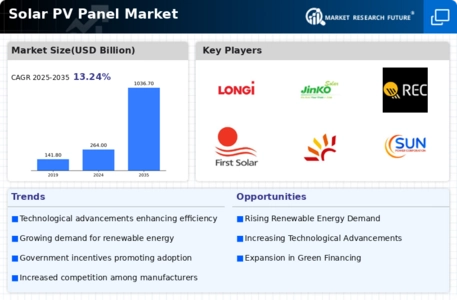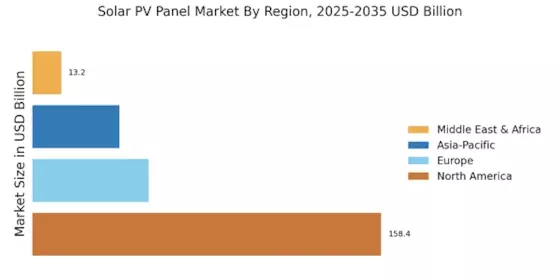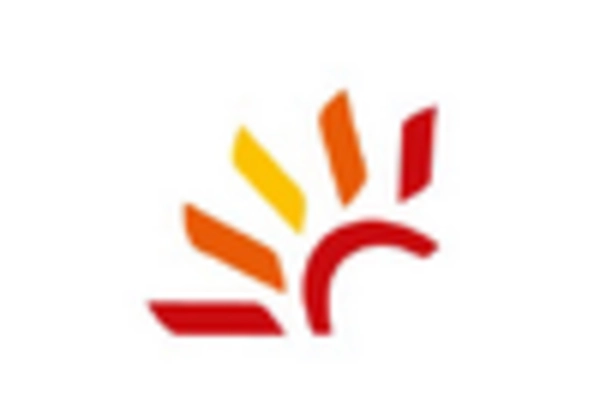Rising Energy Demand
The Solar PV Panel Market is experiencing a surge in demand for energy, driven by increasing population and urbanization. As more individuals and businesses seek reliable energy sources, the need for renewable energy solutions becomes paramount. According to recent data, energy consumption is projected to rise by approximately 30% by 2040. This trend indicates a growing reliance on solar energy, as it offers a sustainable alternative to fossil fuels. The Solar PV Panel Market is well-positioned to meet this demand, providing innovative solutions that cater to both residential and commercial sectors. The shift towards energy independence further fuels this growth, as consumers and governments alike prioritize sustainable energy sources. Consequently, the Solar PV Panel Market is likely to expand significantly in response to these evolving energy needs.
Government Support and Incentives
The Solar PV Panel Market benefits significantly from government support and incentives aimed at promoting renewable energy adoption. Various countries have implemented policies such as tax credits, rebates, and feed-in tariffs to encourage the installation of solar energy systems. For instance, recent data shows that countries with robust government incentives have seen solar capacity installations increase by over 50% in the last five years. This support not only reduces the financial burden on consumers but also stimulates investment in solar technology. As governments continue to prioritize renewable energy in their energy policies, the Solar PV Panel Market is likely to experience accelerated growth. The alignment of public policy with market needs creates a conducive environment for the expansion of solar energy solutions.
Declining Costs of Solar Technology
The Solar PV Panel Market is witnessing a notable decline in the costs associated with solar technology. Over the past decade, the price of solar panels has decreased by nearly 80%, making solar energy more accessible to a broader audience. This reduction in costs is attributed to advancements in manufacturing processes and economies of scale. As prices continue to fall, more consumers are likely to invest in solar solutions, thereby driving growth in the Solar PV Panel Market. Furthermore, the decreasing costs of installation and maintenance contribute to the overall affordability of solar energy systems. This trend not only enhances the attractiveness of solar energy but also encourages widespread adoption, positioning the Solar PV Panel Market for sustained growth in the coming years.
Environmental Concerns and Sustainability
The Solar PV Panel Market is increasingly influenced by growing environmental concerns and the push for sustainability. As climate change becomes a pressing issue, there is a heightened awareness of the need to reduce carbon emissions and transition to cleaner energy sources. Solar energy, being renewable and non-polluting, aligns with these sustainability goals. Recent studies indicate that solar power could potentially reduce greenhouse gas emissions by up to 80% by 2050. This shift towards environmentally friendly energy solutions is driving investments in the Solar PV Panel Market, as both consumers and businesses seek to minimize their ecological footprints. The emphasis on sustainability is likely to propel the Solar PV Panel Market forward, as it becomes a key player in the global transition to a low-carbon economy.
Technological Innovations and Efficiency Improvements
The Solar PV Panel Market is propelled by ongoing technological innovations and improvements in efficiency. Advances in solar cell technology, such as bifacial panels and perovskite cells, are enhancing energy conversion rates and overall performance. Recent developments indicate that new solar technologies could achieve efficiencies exceeding 25%, significantly boosting the viability of solar energy. These innovations not only improve the performance of solar panels but also reduce the space required for installations, making solar energy more appealing for urban environments. As technology continues to evolve, the Solar PV Panel Market is expected to benefit from increased adoption rates and enhanced consumer confidence in solar solutions. The continuous pursuit of efficiency and innovation positions the Solar PV Panel Market for robust growth in the foreseeable future.


















Leave a Comment